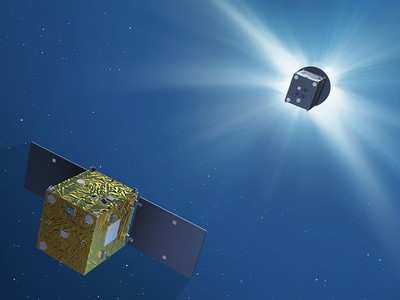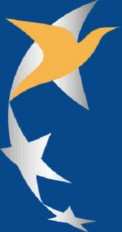EASA: Flying Multiple Satellites Together In Formation Is "The
Real Cutting Edge"
All space missions are difficult. Docking a pair of spacecraft
is tough but flying multiple satellites together in formation is
considered the real cutting edge. A new simulator is now allowing
mission planners to get to grips with multi-satellite missions to
come, starting with ESA's Proba-3. Several space agencies are
preparing formation-flying missions, but it is hard to overstate
the difficulty they face: separate expensive pieces of hardware,
each one zipping through space at several kilometres per second,
may have to manoeuvre to within metres of each other to achieve
their goals.

EASA Image Of Satellites In Formation
Simulation
The relative positions of the satellites must be maintained
precisely as they close in: lose control of one part of the
formation, even momentarily, and the satellites risk destruction.
And orbital dynamics dictate the satellites' orbits will tend to
cross as they circle Earth, another worrying factor for their
controllers. Even so, there are specific tasks only formation
flying can do - and a new computing resource should help to achieve
them.
The Formation Flying Test Bed is a suite of software running
across linked computers to simulate all aspects of a
formation-flying mission. Overseen by ESA's Software Systems
division at the agency's ESTEC space research and technology centre
in the Netherlands, this new facility can emulate the running of
more than a single satellite at once. "It is a generic simulator
for formation-flying missions, whether they include two spacecraft
or as many as five or six," explained Raffaella Franco.
"Simulations are a computer-intensive business anyway, but trying
to emulate more than one spacecraft's onboard computer and software
simply will not run on a single computer, not to mention the rest
of the satellite and the associated ground systems and
inter-satellite links. Instead, the Formation Flying Test Bed
allows the distribution of software across multiple computers
without affecting the user experience."
The testbed addresses crucial operational factors for formation
flying, including mission and vehicle management, guidance
navigation, dealing with faults and communicating between
satellites. The facility can also be used for training satellite
controllers, preparing new procedures or even as a troubleshooting
tool once a mission has made it to orbit.

To help develop the testbed a demonstration model was created
based on Proba-3, ESA's first formation flying mission, due for
launch in 2014-15. Proba-3's two satellites will form the first
'external coronagraph' in orbit, with one satellite maintaining an
artificial eclipse of the Sun as seen from the other, so that
hidden details of the solar corona can be seen.
The testbed was developed by Belgium's Spacebel, also
responsible for Proba-3's flight software. The project was backed
through ESA's General Support Technology Programme, which aims to
mature prototypes into operational hardware.
 NTSB Final Report: Rutan Long-EZ
NTSB Final Report: Rutan Long-EZ ANN FAQ: Turn On Post Notifications
ANN FAQ: Turn On Post Notifications Classic Aero-TV: ICAS Perspectives - Advice for New Air Show Performers
Classic Aero-TV: ICAS Perspectives - Advice for New Air Show Performers ANN's Daily Aero-Linx (06.28.25)
ANN's Daily Aero-Linx (06.28.25) Aero-News: Quote of the Day (06.28.25)
Aero-News: Quote of the Day (06.28.25)




